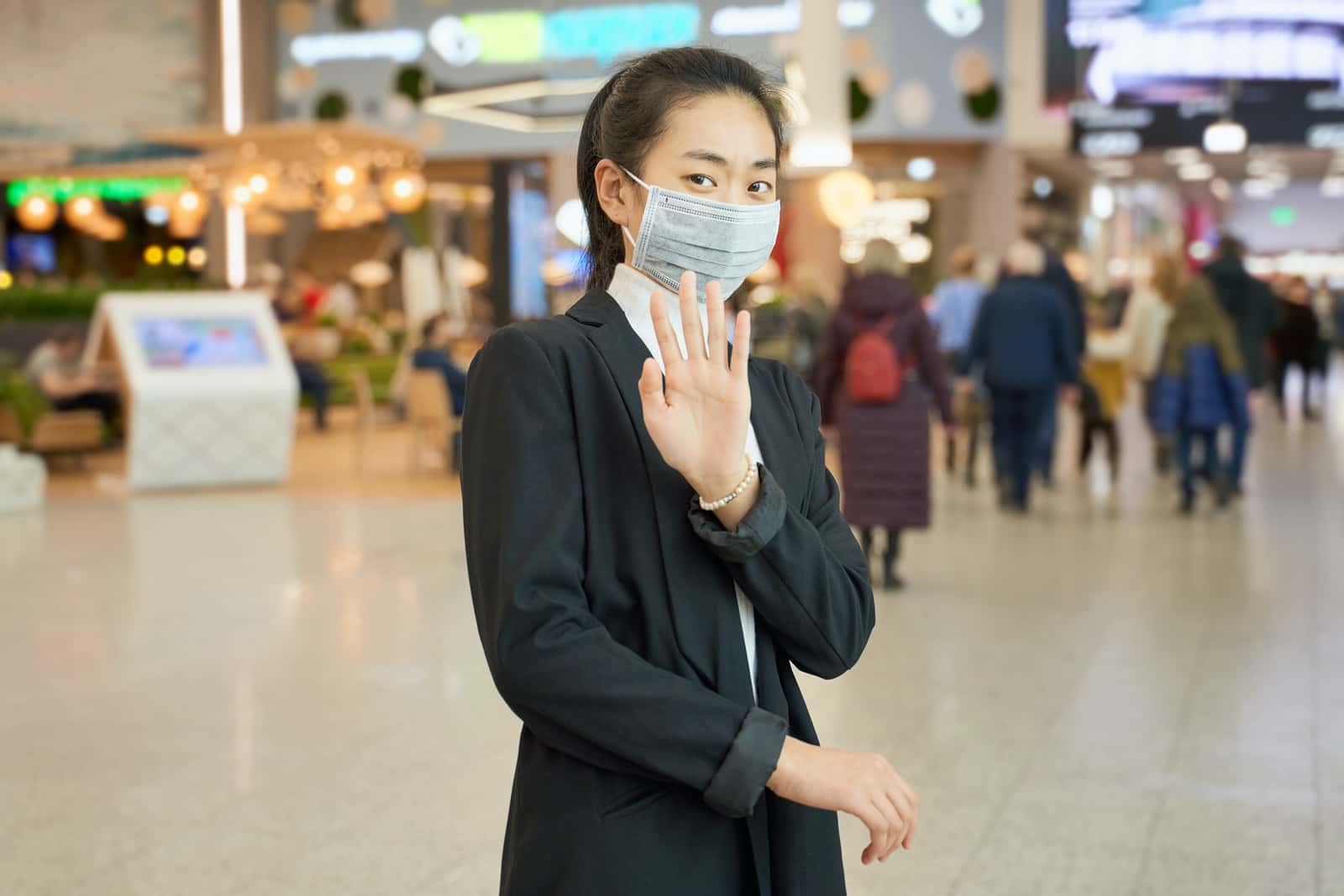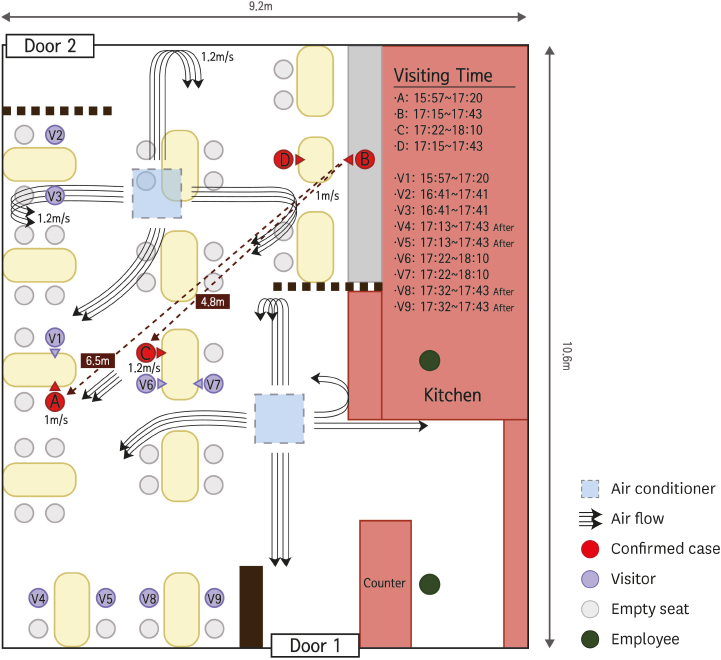
Americans have been told by the CDC that if they just stand at least 6 feet away from people they will be able to avoid catching COVID-19. Here are the precise words the CDC uses in its guidelines: “To practice social or physical distancing, stay at least 6 feet (about 2 arms’ length) from other people who are not from your household in both indoor and outdoor spaces.” We’re sorry. A new study from South Korea suggests that recommendation won’t protect you from COVID-19.
A Korean Restaurant and the Spread of COVID-19:
An article in the Journal of Korean Medical Science (Nov. 30, 2020) suggests that six feet of separation won’t protect you from COVID-19.
The story starts with this question:
How did a high school senior catch COVID-19?
This young woman in Jeonju, South Korea was very careful. She basically went from her home to her school and back each day. In the month of June of 2020 there had been no cases of COVID-19 in the city of Jeonju. Zero! And the South Korean public health authorities were being exceptionally vigilant. The KDCA (Korea Disease Control and Prevention Agency) keeps careful track of all coronavirus cases.
Symptoms of COVID-19:
That’s why everyone got excited when the high school senior started demonstrating coronavirus symptoms on June 16. She tested positive for SARS-CoV-2 on June 17. Immediately, the Epidemic Investigation Support System (EISS) went into contact tracing red alert. This person was identified as index case A.
These sleuths interviewed the student and found out that she had not traveled outside the city. They also accessed the student’s cell phone and credit card information. They cross referenced the GPS and credit card data with that from any known cases of COVID-19 between June 2 and June 15.
Here is what they discovered:
“The results showed only one (case B) of 538 confirmed domestic cases with a tracking map overlapping that of case A during that period. The site of overlap was a restaurant (restaurant A), where case A and case B were co-located for 5 minutes on June 12 based on CCTV [closed-circuit television] images. Case B lives in Daejeon Metropolitan city within an hour’s drive away from Jeonju, and visited Jeonju only on June 12. Therefore, we tentatively considered case B is the primary case (infector) and case A as the secondary case (infectee).”
Time Out:
Take a minute or two and process what happened in South Korea:
The EISS team sprang into action as soon as the high school student reported symptoms. They had results of her COVID test the next day. Within hours they had searched their electronic tracking system and identified the “infector” case B. Within two to three days the investigators had identified the other people in the restaurant as well as the employees, had them tested and required a 12-day quarantine. One other visitor to the restaurant, case C, also turned out to be infected with the coronavirus.
In the United States we have nothing even close to this kind of track and trace system. Contact tracing has been all but abandoned in the US. Perhaps that is one reason why we have been so unsuccessful at controlling the spread of the virus.
Who Spread COVID-19?
Case B from Daejeon, South Korea is a traveling saleswoman. On June 12 her company was having a meeting on the sixth floor of the building where restaurant A was located.
The high school student (case A) walked into the restaurant on the ground floor with a friend at precisely 4:00 pm. We know that exact time because the CCTV recorded her entrance.
Case A and her friend finished eating by the time case B and a friend entered the restaurant at 5:15 pm through door 2. Remember, case B was infected with COVID-19. This “infector” and the friend sat at a table near door 2. The table was 6.5 meters (m) or 21 feet away from the table where case A was sitting.
Case A and her friend left the restaurant 5 minutes after case B arrived. She left using door 1 and never came close to case B. Here is the bottom line:
The overlap between case A (infectee) and case b (infector) was a total of 5 minutes at a distance of 21 feet. That’s all it took for the virus to travel from case B to case A and lead to transmission of SARS-CoV-2. Based on this data, six feet of separation won’t protect you from COVID-19!
The infector and infectee never spoke to each other. Neither touched anything the other had handled. That included dishes, doorknobs or anything else. Case A did not exit the restaurant by walking close to the infector because she left from a different door (door 1).

Journal of Korean Medical Science, Nov. 30, 2020, restaurant floor plan in Jeonju, South Korea
Solving the Mystery: Why Six Feet Won’t Protect You From COVID-19!
The researchers called in to resolve the mystery attempted to recreate the “crime scene.” They sat at the same tables as the people in the restaurant and measured the airflow throughout the room.
What they discovered was that the student, and another restaurant diner (case C) who became infected, were in the direct line of airflow from the air conditioning system. People who did not face the flow of air did not become infected. None of the people in direct proximity to case B wore face masks.
The research was incredibly thorough. The investigators measured airflow precisely. They also analyzed the velocity of the air using sophisticated anemometers.
The authors’ conclusions:
“In this outbreak, the distances between infector and infected persons were 4.8 and 6.5 m, [15.75 feet to 21.33 feet] both farther than the generally accepted 2 m [6.56 feet] droplet transmission range. This is some of the first evidence of airborne transmission.”
Another Restaurant Study Confirmation:
This is not the first well-researched restaurant study. We wrote about a fateful lunch in Guangzhou, China, back on May 12, 2020. A mother and daughter caught COVID 19 at distances of 9 feet and 10.5 feet from the index patient (infector). It is entirely possible, though, that the airflow carried viral particles a total of 20 feet and that led to the viral transmission. You can read this article at this link.
Can You Catch COVID-19 From >10 Feet Away?
Some states are reopening restaurants, beauty shops and gyms. Can patrons still catch Covid-19 if they stay 6 feet apart? 10 feet may not be far enough!
Pushback from Readers:
Many of the visitors to our website who read the Chinese study showing that 6 feet of separation won’t protect you from COVID-19 disagreed. They blamed the servers. Another suggestion was that both the infector and the infectees used the same bathroom and the virus was transmitted there, either in the air or by touching the door handle or a faucet. There was a suggestion that the infector may have walked past the infectee. But all those ideas go out the window if we are to believe the South Korean research.
Conclusions from the Authors:
“In the presented case, the air flow from infector to infectee showed 1.0–1.2 m/sec (3.6–4.3 km/hr) velocity, indicating the need for 6.5 seconds of contact to transmit droplets from the infector to the index case…These findings strongly suggest that this outbreak occurred by droplet transmission exceeding a 2 m distance and excluded contact and fomite [object] transmission.”
Genome sequencing proved that the patient’s COVID virus infection was identical to the infector. The authors concluded that airborne transmission of the virus can occur at distances greater than 6 feet “if there is direct air flow from an infected person in an indoor setting.”
Journal of Korean Medical Science, Nov. 30, 2020
The People’s Pharmacy Perspective:
So why did I go into the weeds to describe this new research and what does it mean for you? First, we think we can conclude that six feet of separation won’t protect you from COVID-19 if you are not wearing a mask. Second, airflow matters. The South Korean researchers were meticulous in measuring the velocity and direction of the airflow in the restaurant. Most of us don’t think about airflow in grocery stores, banks, post offices, schools, cars or airplanes.
Airlines have told us that they have great air circulation and purification. We wonder, though, whether six feet of separation on an airplane is enough to protect you from COVID-19 if someone nearby is spewing virus and you are in the path of the airflow.
What about outside? The advantage of the great outdoors is that there is a lot of airflow. Chemical companies have often stated that dilution is the solution to pollution. We’re not so sure about that, but outside air is much safer than inside air. There is major air dilution outside. That said, if a bunch of runners zip past you in a park breathing heavily and you are following in their wake, it might be a good idea to have your mask on.
We have long questioned the idea that 6 feet of distance is magical. Based on the South Korean study, we don’t think that 6 feet of separation will protect you from COVID-19. A mask should help, though. You can learn more about airborne viral transmission by listening to our podcast with two of the world’s most knowledgeable experts on this topic at this link.
Show 1227: What Do You Need to Know About Airborne Virus?
Ventilation is crucially important when it comes to preventing the spread of airborne virus. Learn how to protect yourself.
If you think someone you know might benefit from reading this article, please scroll to the top of the page and send it via email, Facebook or Twitter. Thank you for supporting our work. Feel free to share your thoughts in the comment section below. Please be courteous.
Citations
- Keun-Sang, K., et al, "Evidence of Long-Distance Droplet Transmission of SARS-CoV-2 by Direct Air Flow in a Restaurant in Korea," Journal of Korean Medical Science, Nov. 30, 2020, https://doi.org/10.3346/jkms.2020.35.e415

